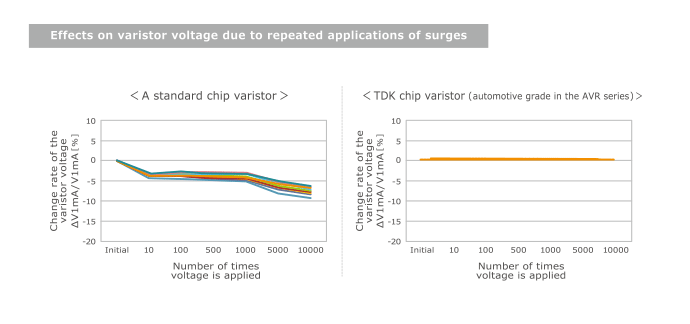Chip Varistors Prevent Damage of Electronics from Electrostatic Discharge
TDK's chip varistors in the AVR series, which are made with our own materials, feature high resistance to repeated surges. Products that substitute Zener diodes in compact devices such as solenoid valves and stepping motors, which are rapidly and frequently turned on and off, are also available.
They can serve as substitutes for components such as Zener diodes in solenoid valves and stepping motors
This article describes the features of TDK's chip varistors in the AVR series that excel in resisting repeated surges as well as the advantages of using them as substitutes.
Figure 1 The generation of surges due to counter electromotive force in the inductive load and the role of surge protection devices
Great amounts of counter electromotive force are generated when the power is turned off in devices with inductive load using coils such as motors, transformers, and solenoid valves due to the self-induction function of the coils, and this results in pulsive surges with high peaks ranging from several to over ten times the supplied voltage. Various surge protection devices such as surge absorbers and surge killers are used because these surges can cause circuits to malfunction or damage peripheral components such as semiconductor devices.
Devices such as chip varistors, Zener diodes, and TVS diodes are used in systems with relatively low circuit voltages. In any case, the circuits are protected by suppressing overvoltage that generates surges (Figure 1).
Chip varistors manufactured with a multilayering process are used in many electronic devices as for surge protection and ESD (electrostatic discharge) measures as they are compact but show excellent surge absorption performance and they are beneficial in terms of mounting space as well as in terms of cost. However, diodes such as Zener diodes and TVS diodes have been traditionally chosen for devices such as solenoid valves and a stepping motor (Figure 2) with high inductive load used while frequently being turned on and off. This is because chip varistors gave the impression that they are vulnerable to repeated surges generated from the power being frequently turned on and off.
TDK's chip varistors in the AVR series, which are made with our own materials, feature high resistance to repeated surges. Products that substitute Zener diodes in compact devices such as solenoid valves and stepping motors, which are rapidly and frequently turned on and off, are also available. Substitutions for Zener diodes also have various advantages.
Figure 2. A structural example of solenoid valves and the basic configuration of the drive system of a stepping motor
Related Links
Product Overview
The properties of the grain boundaries that surround the ZnO (zinc oxide) crystal grains express the varistor characteristics
"Varistor" is a compound word and an abbreviation for "Variable Resistor" referring to resistors. It is a non-linear resistive element with voltage-current characteristics that do not obey Ohm's Law. Figure 3 shows the internal construction of a chip varistor.
Chip varistors are SMD components where internal electrodes are printed out on a sheet of varistor material with various additives added to the main raw material of ZnO (zinc oxide) and layered, followed by cutting to fit the designated chip size and their terminal electrodes being formed with plating after sintering in a firing furnace. The sintered varistor elements are semiconductor ceramics that are polycrystaline bodies composed of fine ZnO grains. During the sintering process, the additives segregate around the crystal grains and form high-resistance grain boundaries. For this reason, chip varistors show high resistance to low voltages such as circuit voltages and signal voltages, but the resistance values suddenly drop when there is overvoltage that exceeds a certain value and the overvoltage flows as surge currents. These voltages are known as varistor voltages and are indicated as V1mA because the voltages between the terminals when DC1mA currents flow between them are usually predetermined. Such expressions of varistor characteristics are based on the properties of the crystal boundaries that surround the many crystal grains.
Figure 3. Internal construction of a chip varistor and the polycrystalline body structure and grain boundaries of ZnO
particles (pattern diagram)
The size of the current where the characteristics of varistors can be processed without deteriorating is called the surge current withstand and the size of the energy where the characteristics can be absorbed without deteriorating is called the surge energy withstand.
Varistor voltages tend to decrease gradually when varistors repeatedly absorb surge currents that exceed the ratings. It is explained that this is because grain boundary layers become partially damaged due to Joule heat that occurs each time when surge currents flow repeatedly.
Figure 4 shows a general example of how chip varistors deteriorate. The dissolving of internal electrodes and the melting of varistor elements can occur due to heating if deterioration progresses.
This can lead to short circuit failures in the chip varistors.
Figure 4 Examples of deteriorating chip varistors due to repeated surges
Related Links
Selection Guides
TDK's chip varistors that excel in resisting repeated surges with the application of our own materials
The resistance of repeated surges in varistors highly depends on the material system in terms of factors such as the types and composition of additives added to the main component of ZnO.
TDK's chip varistors, which are made with our own materials developed with materials technologies, feature excellent resistance to repeated surges, and products that substitute Zener diodes in devices such as solenoid valves and stepping motors, which are rapidly and frequently turned off, are also available.
Figure 5 is a graph that shows a comparison between the characteristics of resistance to repeated surges of a standard chip varistor and those of a TDK chip varistor (automotive grade in the AVR series). The horizontal axis is the number of times a voltage of 15kV has been applied in an IEC6100-4-2 HBM (human body model) test, and the vertical axis is the rate of change of the varistor voltage (V@1mA). The measurements for both of them were made with ten elements.
There was a roughly 5% decrease with the standard chip varistor when there were 10 applications, and a nearly 10% decrease with 10,000 applications. On the other hand, there were no decreases found with TDK's chip varistor even with 10,000 applications, indicating it is dramatically more resistant to repeated surges.
Figure 5 A comparison between a standard chip varistor and a chip varistor made with TDK's own materials: Characteristics of
resistance to repeated surges
Figure 6 is a graph that shows changes in the leakage current at 28Vdc with a repeated application of voltage. There was a roughly 100 times increase of leakage current with the standard chip varistor when there were 10 applications. On the other hand, there were no changes found with TDK's chip varistor even with 10,000 applications.
Figure 6 A comparison between a standard chip varistor and a chip varistor made with TDK's own materials: Changes in leakage current
Figure 7 shows a comparison between the resistance to repeated surges of a standard Zener diode and that of a TDK chip varistor (automotive grade in the AVR series). These are results produced under the same conditions as those of the comparative test in Figure 5. It shows that TDK's chip varistors have excellent characteristics that compare well with those of Zener diodes.
Figure 7 A comparison between a standard Zener diode and a chip varistor made with TDK's own materials: Effects on varistor voltage due to repeated applications of surges
Benefits of replacements with individual chip varistors while combining TVS diodes and capacitors
Chip varistors have both surge absorption capabilities and noise suppressing effects.
Figure 8 shows the equivalent circuit of a chip varistor. The chip varistor is equal to the one where the capacitor is connected parallelly to the two Zener diode elements that are connected opposite to each other. The current-voltage characteristics are symmetric and have no polarity. They normally function as capacitors because of their high-resistance grain boundaries and show noise absorption effects in wide frequency ranges.
Figure 8 The equivalent circuit of a chip varistor
Replacements can be made with a single chip varistor in circuits where ESD countermeasures are implemented with TVS diodes and EMI countermeasures are implemented with capacitors.
Figure 9 Replacement of "a TVS diode + a capacitor" with an individual chip varistor
| Features of chip varistors |
|
|---|
Related Links
Product Overview

Application Note
A wise choice in terms of space, cost, and noise countermeasures
There are various types of varistors, which are surge protection devices, and their characteristics differ greatly according to their material systems.
Devices such as standard disk varistors are used for protection from surges because large solenoid valves and motors are not affected much by counter electromotive force and solenoid valves are resistant to overvoltage. Standard varistors also usually provide sufficient protection to sets when overvoltage is not applied too many times. On the other hand, solenoid valves and stepping motors, which are rapidly and frequently turned on and off may go through over tens or a hundred million applications of overvoltage in their varistors over long periods of use, so it is important to choose the right material system so that deterioration due to such application does not occur.
TDK's chip varistors, which have been developed with materials technologies, feature excellent resistance to repeated surges, and products with characteristics that compare well with Zener diodes are also available as automotive grade types in the AVR series. They can substitute products such as Zener diodes in devices such as compact solenoid valves and stepping motors, which are rapidly and frequently turned on and off. Furthermore, they are beneficial in terms of space, cost, noise countermeasures, noise suppression, and ESD countermeasures because even the 1005-sized compact chip varistors show stable characteristics.
Below are particularly recommended automotive grade chip varistors in the AVR series by TDK (Figure 1). They are all resistant to an applied voltage of 25kV in an IEC-1000-4-2 HBM test and show characteristics of stability even in industrial equipment that requires resistance to repeated superimposed voltages like those above as well as in automotive applications, which require high-reliability and long service life. Below are recommended products that can be used with 12V circuit systems and 24V circuit systems by size.
| Circuit system | Series / type | L×W dimensions [EIA] |
Varistor voltage V1mA @DC1mA (V) |
Rated voltage Vdc (V) |
Capacitance C @1kHz, 1Vrms (pF) |
Operating temperature range (°C) |
|---|---|---|---|---|---|---|
| 12V Circuit system |
AVRH10C270KT150NA8 | 1.0×0.5mm [EIA0402] |
27 | 19 | 15 | -40 to 150 |
| AVR-M1608C220KT6AB | 1.6×0.8mm [EIA0603] |
22 | 16 | 560 | -40 to 125 | |
| AVR-M2012C220KT6AB | 2.0×1.2mm [EIA0805] |
22 | 16 | 800 | -40 to 125 | |
| 24V Circuit system |
AVRH10C390KT500NA8 | 1.0×0.5mm [EIA0402] |
39 | 28 | 50 | -40 to 150 |
| AVRM1608C390KT271N | 1.6×0.8mm [EIA0603] |
39 | 28 | 270 | -40 to 125 | |
| AVR-M2012C390KT6AB | 2.0×1.2mm [EIA0802] |
39 | 28 | 430 | -40 to 125 |











